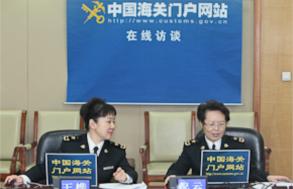 Online Interview
Online Interview
Topic: The Past & the Present of China Customs – about a Close Look into China Customs Museum
Time:10:00 AM (Thu) March 27, 2014
Special Guests: Ni Yun, Curator of China Customs Museum
The Past & the Present of China Customs – about a Close Look into China Customs Museum
[Ni Yun]: China Customs Museum, as a national industry-specific museum, aims at collecting and displaying the history, construction, achievements and relics regarding Customs, and promoting the development of customs undertakings. To put it bluntly, it is a place recording “the past and present of Customs”. So, China Customs Museum welcomes friends who are interested in China Customs and their relevant history to explore our peerlessly rich collections and archives in this regard in China! 03/27/2014 10:06:30
[Wang Hua]: As far as I know, quite a few countries have their own customs museums, which is now a sort of international practice. 03/27/2014 10:07:05
[Ni Yun]: That’s true. Countries like the U.S., the U.K., France, Germany and Russia all have established their customs museums, and the international community has specially set up the International Association of Customs/Taxation Museums. However, the establishment of a customs museum in China is still at a beginning stage. China Customs Museum was officially put into construction in March 2010, with the design, construction and exhibition arrangement for the Permanent Displays section completed in early 2013, and was opened to the customs system internally on September 29 last year. The Museum, having gone through continuous modifications and improvements, is scheduled to be officially open to the public on March 30 this year. 03/27/2014 10:07:28
[Wang Hua]: Could you please tell us about the current collections in the Museum? 03/27/2014 10:08:12
[Ni Yun]: The Museum currently houses more than 18,700 pieces of collections and archives, including more than 13,000 physical collections and more than 5,000 photos. Those collections include customs antiquities reflecting Chinese customs history and contributing significantly to national economic and social development, smuggled antiquities and endangered animal and plant specimens seized by customs offices, among other things. 03/27/2014 10:08:38
[Ni Yun]: So far, the Museum has displayed and kept more than 4,400 collections in its exhibition areas and warehouses, with the remainder of collections and archives kept in the Guangzhou Branch of China Customs Museum and some warehouses for contraband goods in the Customs Districts directly under GACC. 03/27/2014 10:09:11
[Wang Hua]: More than ten thousand collections! Quite a lot! How did the Museum get so many collections? 03/27/2014 10:09:39
[Ni Yun]: In terms of sources, there are primarily five means to get the collections, namely internal requisition within the customs system, private donations, reproductions from museums and archives centers, collection and purchase from the society, and allocation of smuggled antiquities seized by Customs. 03/27/2014 10:10:05
[Ni Yun]: It is worth noting that though all smuggled antiquities seized by Customs officers should be handed over to local administrations of cultural relics, in order to help establish the Customs Museum, the State Administration of Cultural Heritage specially approved that we could requisition part of the smuggled antiquities as collections of the Customs Museum. Among those smuggled antiquities are quite a few treasures, such as bronze swords in the Warring States Period, carved standing figures of Guanyin in the Song Dynasty, Thang-ga. 03/27/2014 10:10:47
[Wang Hua]: Which are the iconic treasures of our Museum? 03/27/2014 10:11:04
Quick Links







